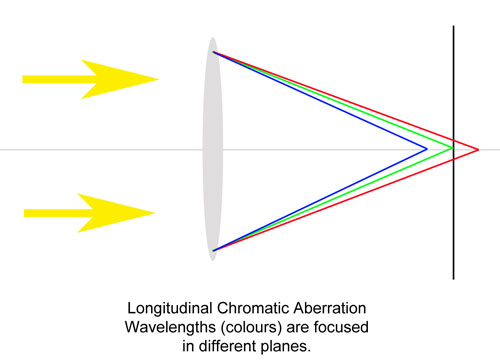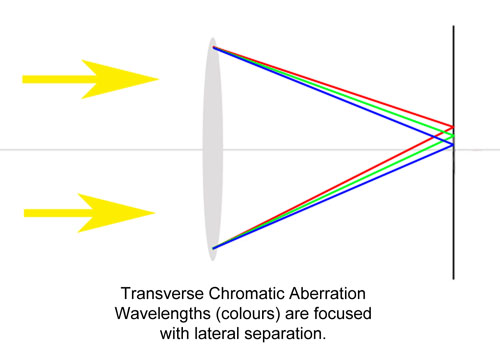The term "chromatic aberration" is used to describe a number of undesirable optical effects which result in unwanted coloured halos or fringes typically seen around high-contrast picture elements (and when employing wide apertures). The effect is a consequence of imperfections in lens design and the characteristics of the glass from which the lens elements are manufactured. The problem is caused when the various wavelengths (colours) of the visible spectrum are focused at slightly different distances, and hence not precisely upon the intended plane of focus. For a point on the optical axis, all wavelengths are focused on the optical axis but displaced longitudinally. This phenomenon is known as longitudinal chromatic aberration (or axial colour) and its extent is dependent upon the dispersion of the glass. (Different wavelengths (colours) of light propagate at different speeds in a medium, so refractive index is wavelength dependent. The resulting phenomenon is known as dispersion.)

A second effect, known as transverse chromatic aberration, occurs when the magnification of a lens changes slightly with wavelength, and different wavelengths are focused on slightly different lateral locations in the image plane. Both effects are typically present in a lens, and ever-higher image resolutions make the effect more and more visible in images. However, it should be noted that similar effects can also be generated by other optical phenomenon - such as flare.

In an attempt to reduce the effects of chromatic aberration, lens designers and manufacturers use multiple lens elements having different refractive indices. Techniques such as these reduce aberration but never eliminate the problem completely. Achromatic lenses have a second element manufactured from glass of a different dispersion to attempt to correct both spherical and chromatic aberration effects. Apochromatic lenses use a third element to bring three visible colours together and hence further correct aberration. However, as complexity increases so the cost of a lens increases.
The highest quality lenses use the best available low-dispersion glass which minimizes the problem of the various wavelengths of light being focused on slightly different locations. Expensive materials such as fluorite are used in the glass, so "low dispersion glass" tends to be very expensive.